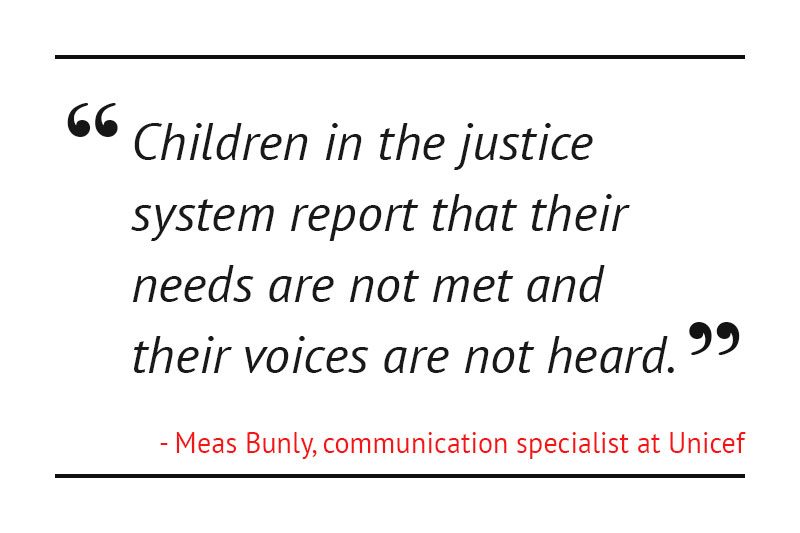Walking to the stand to testify against her rapist, the 17-year-old’s heart began to race. As the judge’s voice boomed across the courtroom, the girl started to worry about what she would say and whether the words would come out right.
The courtroom closed in around her, she told Hagar International, an NGO that protects the rights of child victims in Cambodia’s courts. It felt like a cage.

In an effort to educate the lawyers and other advocates who work with children, Hagar International on Tuesday released a guidebook—largely informed by the study—to help them navigate the legal system without making things worse for the children they represent.
The study, which included 54 children, found many instances where the very courts charged with protecting them actually traumatized them further: through ignorance, indifference or insensitivity. Children were transported to court in the same vehicle as those who had hurt them, the report found.
They were forced to testify in front of the people they accused of raping them, or abusing them or beating them. Prosecutors and judges asked inappropriate questions.
Hagar and Unicef are hoping to eliminate these practices, starting by spreading knowledge of how things should be done.
“Our goal is to ensure that justice courts are friendly and safe places for children who are survivors or witnesses of violence and crime, with clear processes and specialized legal actors to uphold the best interests of the child,” Debora Comini, Unicef’s representative to Cambodia, said in a statement released on Tuesday.
As it stands now, the system “creates this really big problem that makes children think they don’t want to engage or don’t want to provide evidence,” said Deborah Papworth, the project coordinator for Hagar International.
“What we want to do is make sure children come out of the other side empowered,” Ms. Papworth said.
Tackling the civil side of the legal system—empowering lawyers and child advocates with information about resources for children, and ensuring victims and their parents are well informed about their roles and rights in the process—could help, she said.
In addition to releasing the step-by-step guide, 112 people working with children in Phnom Penh, Siem Reap and Battambang provinces have been trained on using the material, Ms. Papworth said.
“There are actually laws that protect children when they’re supposed to go through court,” she said, but “a lot of these practices aren’t used.”
The Code of Criminal Procedure, for example, can be used “to insist on the lawyer’s presence to protect the child during the investigation phase,” while other laws can be used so a child can testify behind a partition or by a video link, the guidebook explains.
The lack of child specialists working in government cripples the search for justice, said Meas Bunly, a communication specialist at Unicef’s country office.
“Children in the justice system report that their needs are not met and their voices are not heard,” he said. “One of the key challenges in the justice system for children is the lack of social workers to assess the situation of children, to provide services and to refer [them] to more specialized services when required.”
In cases where a child does not have a lawyer, the courts are often insensitive to the need for a private court hearing, said Khoem Vando, program manager for anti-pedophile NGO Action Pour Les Enfants.
Once a victim is abused, “it’s already a nightmare which will last almost their entire life,” he said. “So what is going to happen if they’re supposed to talk about this in a courtroom where everyone can hear?”
Prominent legal expert Sok Sam Oeun said that if independent child advocates and lawyers for children do not pursue their rights, “the court does not care.”
Ministry of Justice spokesman Chin Malin, however, said the government was making efforts to ensure child protection laws are enforced, but conceded that “loopholes” remained, and that there was sometimes a lack of information or competent officials.
“We are working on this, but it’s not completely enforced,” he said. “It could be because of a lack of means, material resources, technical understanding and finances.”
Partitions are currently used in courtrooms in Phnom Penh and Siem Reap, for example, but a lack of technical knowledge prevents the use of cameras to question child victims or witnesses from a separate room, according to spokesmen from the courts. They declined to comment on other efforts to ensure child well-being during the legal process.
“I wouldn’t want to say that the courts are necessarily the obstacle,” Ms. Papworth said.
“It’s just that they haven’t reached a stage where there are specialized personnel that work with children.”
Without reforms to the entire legal system, nongovernmental groups will need to continue to take on the brunt of the responsibility of protecting children, Mr. Sam Oeun said.
“Who owns or is accountable to the case? Police? Investigating judges? The judge? All of them say no,” he said.
(Additional reporting by Ouch Sony and Khy Sovuthy)




